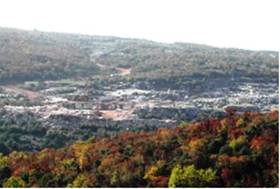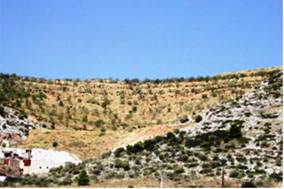Reclamation of mining areas
Mining areas for extracting inert materials for buildings or metals have been extended particularly in dense populated areas in which several times the ground surface remains bare favouring surface water runoff and creating adverse microclimatic conditions. Mining areas must be progressively reclaimed by transporting soil, and covering the exposed bedrock or inert materials for planting species existing in the surrounding area (Fig. 72). Reclamation of mining areas has been defining by evaluating the measurements undertaken for soil erosion control such as terracing, vegetation cover, etc. The following classes have been distinguished for this project: (a) no actions undertaken, (b) low, incomplete protection, less than 25% of the area is protected; (c) moderate, partial protection, 25-75% of the area is protected; (d) adequate, complete protection, >75 of the area is protected.
As Table 10 shows, data for this indicator have been collected for 720 field sites, corresponding to 13 study sites. Data have been provided from the following study sites: Boteti Area-Botswana, Novij Saratov-Russia, Djanybek-Russia, Cointzio Catchment-Mexico, Gois-Portugal, Rendina Basin Basilicata-Italy, Santiago Island-Cape Verde, Mamora Sehoul-Morocco, Zeuss Koutine-Tunisia, and Eskisehir-Turkey. The analysis of the data has shown that no actions have been undertaken for erosion control measures in all study field sites. Probably there might have been overexpectations from this indicator or a misunderstanding in collecting such data related to the not so common reclamation of mining areas.


Fig. 72. Examples of mining areas without any reclamation action (left) and reclaimed after mining activities have been finished (right)